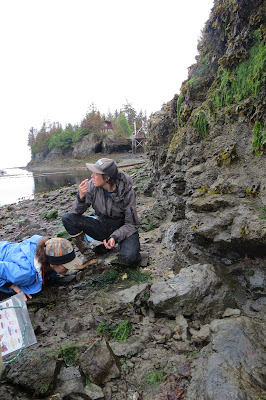Seldom does a day pass when I fail to learn something new from the guests on my tour. Today, a pair of freshwater ecologists from Chicago taught me about the life of Lost and Found Lake.
 |
| A dragonfly's-eye view of Lost and Found Lake. |
Our dragonflies live four to five years as nymphs, chomping on mosquito larvae and overwintering in lake-bottom muck. They molt from nine to twelve times before finally emerging as royal-blue, winged adults. They fly for one summer before dying in the frosts of fall.
Damselflies go through a similar process but spend only two to three years as nymphs, a stage in which they have three tails and long, wriggly body. We found dragonfly and damselfly nymphs when I scooped lake water into my frisbee. (Just one more reason why you should never leave home without one!)
But the most incredible discovery of all came from the ecologists' daughter who scooped a firm, transparent goo blob from the lake. I'm used to unidentified blobs in the intertidal zone, but in freshwater I was out of my element.
Frog eggs? Nope, we have only one amphibian in Alaska (the wood frog, Lithobates sylvaticus) and its eggs look more like clear grapes with a black dot in the middle.
Snail eggs? Perhaps, though I've never seen a snail in this lake.
Then I looked closer. Thousands of tiny green dots were aligned within the blob, perfectly ordered like soldiers on the march. At the edges of the blob, where upper and lower surfaces overlapped, the dots gave a mossy sheen to the blob.
Could it be... Volvox? The spherical, chlorophytic protist from introductory bio lab?
The ecologists and I leaned in. "Look, it has five gas bubbles trapped inside!" one exclaimed. "I think it's respiring!" Oxygen building up inside was the final clue, and the blob was proclaimed to be Volvox.
 |
| A wild Volvox! |
I sacrificed my water bottle for our new friend's transport. Back at the field station, we peered through a microscope to see the tiny green dots up close. They didn't look round, but rather like commas, and they jiggled like worms trapped in a force field.
Volvox is an important tool for biology education because it displays both sexual and asexual reproduction. Asexual reproduction is cooler: miniature, spherical daughter colonies form within the parent blob and are released into the world.
Scientists think Volvox switched from a single-celled organism to a communal enterprise about 200 million years ago, and research into that transition is providing clues about how the evolution of cooperation allowed our single-celled ancestors to become the plants and animals of modern times.
It always startles me to see laboratory species in the wild. The same thing happened with slime mold. In high school, I made mazes for slime mold using oats and Petri dishes, then filmed its decision-making with a time-lapse camera. Slime mold was recently featured in Nature for redefining intelligence! Now, on my daily hikes, I notice slime mold inching around the rotting logs of its home, the coastal temperate rainforest.
 |
| A banana-yellow slime mold seeks shade in the forest of Peterson Bay Field Station. |
Watching slime mold and Volvox do their thing in the wild reminds me of the importance of intact ecosystems. Without old-growth rainforests and healthy lakes, scientists would never have encountered these model organisms that have led to dozens of laboratory-based discoveries and a better understanding of topics ranging from memory to cellular reproduction to our own evolution.
Imagine how many more organisms are out there in unexplored regions of the Amazon, the Arctic, or the deep sea. Who knows what strange life form is going about its daily business of eating, competing, and reproducing, just waiting to be discovered next?




























